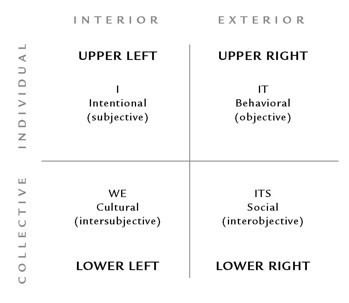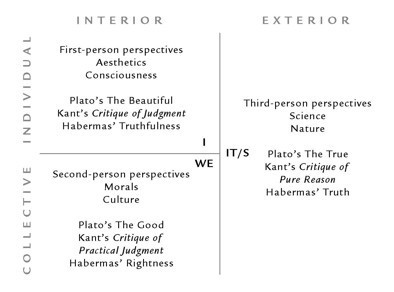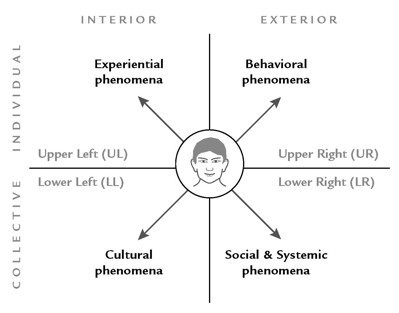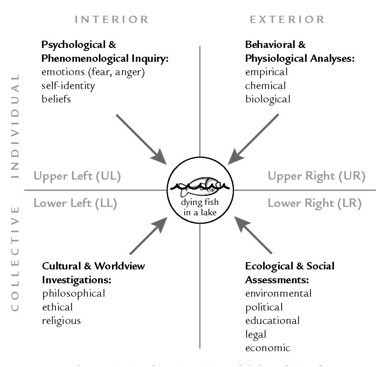All Quadrants: The Basic Dimension-Perspectives
According to integral theory, there are at least four irreducible perspectives (subjective, intersubjective, objective, and interobjective) that must be consulted when attempting to fully understand any issue or aspect of reality. Thus, the quadrants express the simple recognition that everything can be viewed from two fundamental distinctions:
- an inside and an outside perspective and
- from a singular and plural perspective.
A quick example can help illustrate this: imagine trying to understand the components of a successful meeting at work. You would want draw on psychological insights and cultural beliefs (the insides of individuals and groups) as well as behavioral observations and organizational dynamics (the outsides of individuals and groups) to fully appreciate what is involved in conducting worthwhile meetings.
These four quadrants also represent dimensions of reality. These dimensions are actual aspects of the world that are always present in each moment. For instance, all individuals (including animals) have some form of subjective experience and intentionality, or interiors, as well as various observable behaviors and physiological components, or exteriors. In addition, individuals are never just alone but are members of groups or collectives. The interiors of collectives are known generally as intersubjective cultural realities whereas their exteriors are known as ecological and social systems, which are characterized by interobjective dynamics. These four dimensions are represented by four basic pronouns: “I”, “we”, “it”, and “its.” Each pronoun represents one of the domains in the quadrant model: “I” represents the Upper Left (UL), “We” represents the Lower Left (LL), “It” represents the Upper Right (UR), and “Its” represents the Lower Right (LR) (see Fig. 1).

Figure 1. The four quadrants.
As both of the Right-Hand quadrants (UR and LR) are characterized by objectivity, the four quadrants are also referred to as the three value spheres of subjectivity (UL), intersubjectivity (LL), and objectivity (UR and LR). These three domains of reality are discernable in all major languages through pronouns that represent first-, second-, and third-person perspectives and are referred to by Wilber as “the Big Three:” I, We, and It/s. These three spheres can also be characterized as aesthetics, morals, and science or consciousness, culture, and nature (see Fig. 2).

Figure 2. The Big Three.
Integral theory insists that you cannot understand one of these realities (any of the quadrants or the Big Three) through the lens of any of the others. For example, viewing subjective psychological realities primarily through an objective empirical lens distorts much of what is valuable about those psychological dynamics. In fact, the irreducibility of these three spheres has been recognized throughout the history of Western philosophy, from Plato’s True, Good, and Beautiful to Immanuel Kant’s famous three critiques of pure reason, judgment, and practical reason to Jürgen Habermas’ validity claims of truth, rightness, and truthfulness (Fig. 2). Wilber is a staunch advocate of avoiding reducing one of these spheres into the others. Inparticular, he cautions against what he calls flatland: the attempt to reduce interiors to their exterior correlates (i.e., collapsing subjective and intersubjective realities into their objective aspects). This is often seen in systems approaches to the natural world, which represent consciousness through diagrams of feedback loops and in the process leave out the texture and felt-sense of first- and second-person experience.
One of the reasons integral theory is so illuminating and useful is it embraces the complexity of reality in ways few other frameworks or models do. In contrast to approaches that explicitly or inadvertently reduce one quadrant to another, integral theory understands each quadrant as simultaneously arising. In order to illustrate the simultaneity of all quadrants I will provide a simple example with Figure 1 in mind.
Let us say I decide I need to buy some flowers for the garden and I have the thought, “I want to go to the nursery.” The integral framework demonstrates that this thought and its associated action (e.g., driving to the garden store and purchasing roses) has at least four dimensions, none of which can be separated because they co-arise (or tetra-mesh) and inform each other. First, there is the individual thought and how I experience it (e.g., mentally calculating travel time, the experience of joy in shopping, or the financial anxiety over how I will pay for my purchase). These
experiences are informed by psychological structures and somatic feelings associated with the UL quadrant. At the same time, there is the unique combination of neuronal activity, brain chemistry, and bodily states that accompany this thought, as well as any behavior that occurs (e.g., putting on a coat, getting in the car). These behaviors are associated with various activities of our brain and physiological activity of the body, which are associated with the UR quadrant. Likewise, there are ecological, economic, political, and social systems that supply the nursery with items to sell, determine the price of flowers, and so on. These systems are interconnected through global markets, national laws, and the ecologies associated with the LR quadrant. There is also a cultural context that determines whether I associate “nursery” with an open-air market, a big shopping mall, or a small stall in an alley, as well as determining the various meanings and culturally appropriate interactions that occur between people at the nursery. These cultural aspects are associated with worldviews in the LL quadrant.
Thus to have a full understanding of and appreciation for the occurrence of the thought, “I’m going to the nursery,” one cannot explain it fully through just the terms of either psychology (UL), or neurobiology and physiology (UR), or social and economic dynamics (LR), or cultural meaning (LL). For the most complete view, as we will see, one should take into consideration all of these domains (and their respective levels of complexity). Why is this practical? Well if we tried to summarize this simple situation by leaving out one or more perspectives, a fundamental aspect of the integral whole would be lost and our ability to understand it and address it would be compromised. Thus, integral practitioners often use the quadrants as their first move to scan a situation or issue and bring multiple perspectives to bear on the inquiry or exploration at hand.
Quadrants and Quadrivia
As noted above, there are at least two ways to depict and use the quadrant model: as dimensions or as perspectives. The first, a quadratic approach, depicts an individual situated in the center of the quadrants (see Fig. 3). The arrows point from the individual toward the various realities that he can perceive as a result of his own embodied awareness. Through his use of different aspects of his own awareness, or through formal methods based on these dimensions of awareness, he is able to encounter these different realities in a direct and knowable fashion. In brief, he has direct access to experiential, behavioral, cultural, and social/systemic aspects of reality because these are actual dimensions of his own existence. This is useful to him because it empowers him to notice, acknowledge, and interact more effectively with his world. In short, the more of these “channels” he has open the more information he will be obtaining about what is happening around him and he will be able to feel and act in ways that are timely and insightful. Notice right now how you are engaged in all three perspectives: first-person (e.g., noticing your own thoughts as you read this), second-person (e.g., reading my words and interpreting what I am trying to convey), and third-person (e.g., sitting there aware of the light, sounds, and air temperature around you). Do you see how you are always experiencing the world from all four quadrants—right here, right now? It is that simple.

Figure 3. The four quadrants of an individuals.
Another way to represent the quadrant model is as a quadrivia. Quadrivia refers to four ways of seeing (quadrivium is singular). In this approach the different perspectives associated with each quadrant are directed at a particular reality, which is placed in the center of the diagram. Let us say hundreds of fish are dying in a lake. The death of these fish become the focus or object of investigation and analysis, with expertise from each of the quadratic domains evaluating the situation. The arrows pointing toward the center indicate the methodologies that different experts (associated with each quadrant) use to study the dying fish. In an integral approach these include exploring the emotions, self-identities, and beliefs of individuals who live on the lake through psychological and experiential inquiry; exploring the empirical, chemical, and biological factors contributing to the dying fish through behavioral and physiological analyses; exploring the philosophical, ethical, and religious viewpoints of the community around the lake through cultural and worldview investigations; and exploring the environmental, political, educational, legal, and economic factors of the situation through ecological and social assessments (see Fig. 4)

Figure 4. The four quadravia of a lake.
In sum, the quadrants highlight four irreducible dimensions that all individuals have and quadrivia refer to the four fundamental perspectives that can be taken on any phenomena. In either case, the four quadrants or quadrivia are co-nascent—literally “they are born together” and are mutually implicated in one another. In other words, they co-arise and tetra-mesh. This understanding is useful because it honors the complexity of reality in a way that allows the practitioner to address problems in a more skillful and nuanced way. Furthermore, the quadrants represent the native ways in which we experience reality in each moment and quadrivia represent the most common ways we can and often do look at reality to understand it.


